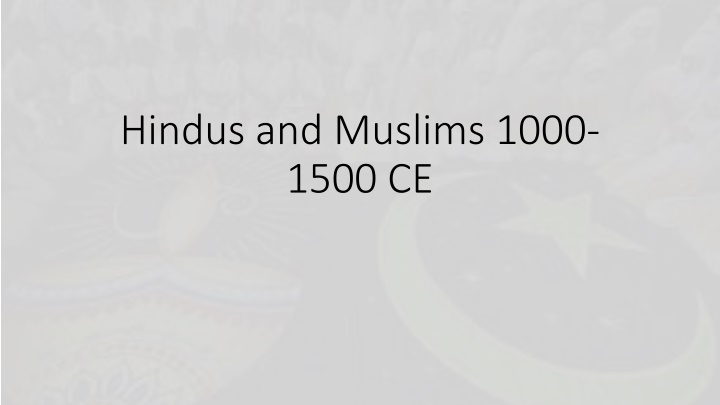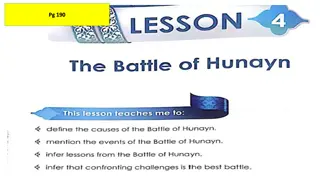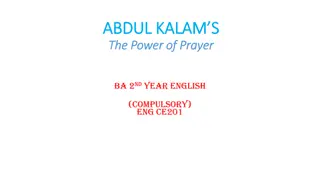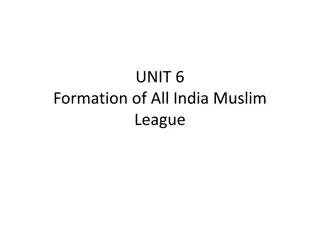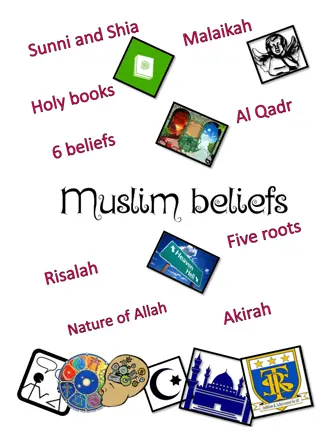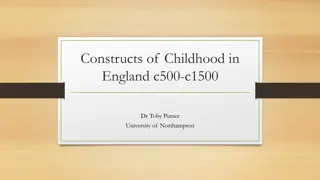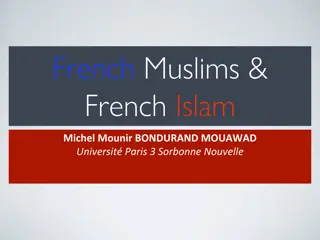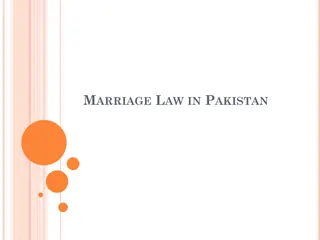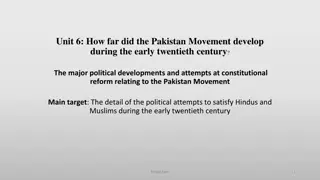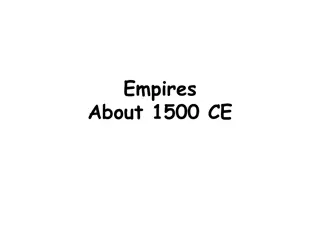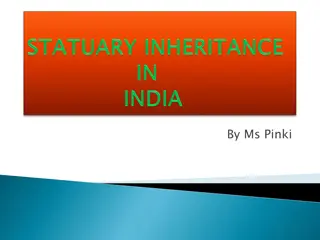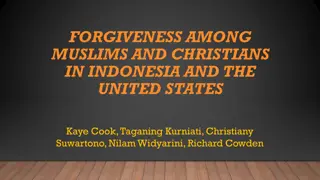Hindus and Muslims 1000-1500 CE
The historical period from 1000 to 1500 CE witnesses significant interactions between Hindus and Muslims, shaping religious, cultural, and political landscapes. This era marked instances of conflict, cooperation, and cultural exchanges, influencing societal dynamics and historical developments in the Indian subcontinent. Exploring this period provides insights into the complexities of interfaith relations and the evolution of religious traditions.
Download Presentation

Please find below an Image/Link to download the presentation.
The content on the website is provided AS IS for your information and personal use only. It may not be sold, licensed, or shared on other websites without obtaining consent from the author.If you encounter any issues during the download, it is possible that the publisher has removed the file from their server.
You are allowed to download the files provided on this website for personal or commercial use, subject to the condition that they are used lawfully. All files are the property of their respective owners.
The content on the website is provided AS IS for your information and personal use only. It may not be sold, licensed, or shared on other websites without obtaining consent from the author.
E N D
Presentation Transcript
Hindus and Muslims 1000- 1500 CE
Start with more recent history! 1947 the British leave India, but leave behind a partitioned subcontinent Two countries (later three): India, Pakistan (1971, also Bangladesh) Pakistan created as homeland for Indian Muslims from Muslim majority areas of the subcontinent Partition saw unbelievable amount of violence between Hindus and Muslims, over a million die and 10-15 million forced to move Created antagonisms that have been read back into history
But who are Hindus? The category Hindu describes a whole range of devotional and ritual practices It describes folks divided by caste Describes a range of folk whose history is a history of migration So, who is Hindu? Dasas of Vedic period? Animists whose practices incorporated thru PURANAS? Lower castes who were not allowed even to listed to Vedas? Buddhists? Bactrians, Scythians, Huns? Rajputs, who were very recent migrants
A Hindu India? Islam represented as foreign to India, but we have also discussed the problem of who is foreign going all the way back to the Arya migrants ca. 1500 BCE, through to the 6th or 7th CE migrants, the Huns, who became the archetypical Hindus, the Rajput Most importantly, ca. 1000 CE, there was no notion of Hindu unity and certainly none of India" being defended against foreigners Example: The raids of Mahmud of Ghazni end in 1030 with his death. Between these raids and the next major invasion from the North West (Muhammad of Ghur), there was a gap of almost a hundred and fifty years. In this period Rajput power and authority increased across north India. Yet, no attempt made to fortify the passes in the North west through which invaders came, nor any attempt at a unified response. Rajputs were divided, lot of infighting, and for them war had almost become sport
Cultural Developments in the Sultanate Era Continue the decentralized polities of previous 500 years or so but culturally a period of incredibly rich fusion Critical developments in art and architecture, with a new kind of dome and arch introduced to India Innovations in art, with a new school of miniature paintings developed, that fuse into one what has come to be known as the Indo-Islamic style Major literary and technological and scientific changes, with exchange of ideas between Indian scholars and those of the Islamic world Modern regional languages developed in this period, as did important forms of music and cuisine What we know of as the Classical music of North India was created with significant inputs from one of nobles of the Allaudin Khalji s court AMIR KHUSRAU Khusrau was a disciple of Nizammudin Auliya, a CHISTI Sufi saint, and composed many fine poems -- not only in Persian or Arabic, but also in the local language of the region. His contributions help it develop into the language we today call HINDI, spoken by 65% of Indians, and functions as India's national language Khusrau also credited with invention or innovation of many musical instruments, including the SITAR
How does one explain conversion to Islam? Start with four theories of conversion : What are they? 1. Conversion by the SWORD, most common why is this flawed? What sort of ARGUMENTS and what DATA does he provide to refute this theory? 2. Religion of patronage, OK, but neither accounts for very large numbers, or the geographical spread 3. Religion of Social Liberation Why is THAT flawed? That people converted to the ideals of the Enlightenment and the French Revolution before they converted to Islam!
Eatons own argument 1 Central to his argument is that before we try to understand WHY people converted, we need to understand WHO converted Converts from the FRONTIERS of Indian society (East and West) who were not already affiliated to any major religious system, nor integrated into agricultural practices If you think back to Gupta era or even earlier, settled agriculture and incorporation into Hindu beliefs (and into the varna-jati system) were simultaneous processes The reason why Muslim populations in the subcontinent had the peculiar concentrations (that allowed for a [much-later] physical partition into two nation-states) was because areas on the frontiers east and west -- had large groups who had not been incorporated into existing major religious systems
Conversion by the Plough 1 In the west, JATS, who are today an agricultural community, but were originally nomadic cattle herders 16thcentury begin process of sedentarization Jats, who became agriculturalists SUFI saints (Muslim mystics) given land grants in the frontiers WESTERN PUNJAB by Mughals in 16thC (as Gupta kings had to Brahmins in their time) Sufi shrines incorporate Jats into a new economic order, and along with it, a cultural practice -- Islam
Conversion by Plough 2 In the east, EASTERN Bengal has most Muslims Shift in river Ganges eastward in the 16thC opens up arable land Here again Muslim intermediaries (Pirs) introduce rice cultivation to former forest-dwelling non-agrarian communities So important that even today being a good Muslim is closely associated with being a good farmer
What was conversion? SLOW and long drawn process marked by TWO phases, FIRST phase, from 13 to 19thcenturies, ACCRETION, when being Muslim did not mean an adherence to ONLY Islamic beliefs, but also a variety of other local beliefs and practices NAMES e.g., (bottom p. 113): from 13thto 15thcenturies only 10% names of a particular community professing to be Muslims in Punjab had ISLAMIC names. In 15thto 17thC 56%, and only by early 19thC were all names Muslim names SECOND PHASE19thC improved communications, and politics saw a REFORM movement emerging, making people more conscious of identity as MUSLIMS. Reforms urged adherence to Islamic principles as laid out in the Quran CONVERSION to ISLAM, much the same PROCESS that conversion to Hinduism, closely related to economic life, and though political power plays a role in both, not the determinant factor
Eaton: Two concentrations of Muslim populations in East and West
